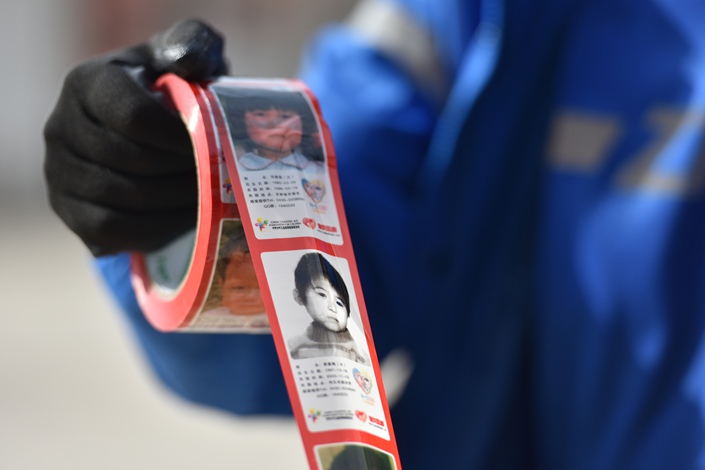
The case of the mother of eight found chained by the neck in a rural county in Xuzhou, East China’s Jiangsu province, has generated an outpouring of public concern about the issue of abducted women.
In response, the Ministry of Public Security has launched a special campaign to crack down on trafficking women and children until the end of the year. The campaign aims to severely punish people involved in kidnapping and trafficking and to rescue abducted women and children by efficiently solving recent and longstanding cases. The Ministry of Public Security will directly supervise the handling of a number of old and unsolved major cases that have had devastating consequences. The Chinese government’s announcement on the battle against the backlogs of cases shows its determination to implement the campaign while striking at the root of human trafficking.
As many of these cases are old and run across multiple provinces, they will be difficult to crack. This difficulty provides a touchstone for testing whether the campaign will be able to fulfill its purpose. The weak governance of the “buyer’s market” has become a huge obstacle to making breakthroughs in the backlog of cases, so striking the “buyer’s market” has become a severe test.
Human trafficking in China was rampant in the era of the people’s communes and peaked in the 1980s and 1990s. Studies have shown that from 1968 to 2008, more than 1 million women and children were trafficked to eastern provinces from old revolutionary base areas, areas inhabited by ethnic groups, remote and border areas and poor areas, such as the provinces of Yunnan, Guizhou and Sichuan. Authorities have taken many actions to fight trafficking. Since 2007, China has issued three anti-trafficking action plans. An institutionalized anti-trafficking system has gradually been developed, and the efforts to fight abductions have achieved remarkable results. Cases of trafficking in women and children fell by 88.3% from 2013 to 2021. At present, fewer than 20 cases of theft of children are filed every year. However, there are still many unsolved cases, behind which are the tears, blood and struggle of countless women.
The most pressing task is to conduct a comprehensive investigation and rescue abducted women, and this needs to be done fast. Women with intellectual disabilities or mental illnesses should be given special attention. Many abducted women have already had children and on the surface might seem like they are living normal lives. Some abducted children have already become adults, and some have even got married. Many of these cases often involve entanglements of law, reason and emotion, making the handling of the follow-ups a thorny matter. However, there are two basic principles that must be followed. First, the will of the abducted woman or child must be respected. Many abducted women have endured years of suffering, yet when applying for divorce, their applications might still be rejected. Such a mechanical and absurd application of the law not only causes secondary harm to these women but also makes a mockery of the rule of law. Second, criminals must be punished in accordance with the law.
The Ministry of Public Security has stated that efforts must be made to eradicate the breeding ground for trafficking and establish and improve an integrated working mechanism to stop trafficking, as well as the assistance and resettlement of trafficked persons. Facts have proved that the fundamental measure to prevent the spread of trafficking is economic and social development. The reason for the resurgence of human trafficking, despite continuous actions to hinder it, is criminals’ lustful desire for money and the impoverishment and backwardness of places where the victims are trafficked from. The eagerness of people to change their lives, coupled with the limited availability of information, makes them vulnerable. Today, many places with a history of trafficking have achieved rapid development, public awareness of trafficking has been significantly improved and the strength of anti-trafficking law enforcement has been continuously enhanced. However, the “buyer’s market” in abduction destinations has evolved into a zone where the fight against trafficking is weak. The incident of the chained woman in Xuzhou is so extreme that it has caused public outrage. However, it was not dealt with properly or in a timely matter. Therefore, we need to take a good hard look at ourselves in the mirror.
In addition to improving the prevention, detection and rescue mechanism in the “buyer’s market,” it is more important to make the buyers subject to legal punishment. Under the current law, whoever buys an abducted woman or child can be sentenced to up to three years in prison, criminal detention or public surveillance. According to the law, whoever buys an abducted woman or child and illegally deprives the victim of his or her personal freedom or commits any criminal acts such as harming and humiliating the victim, shall be convicted and punished in accordance with the relevant provisions on combined punishment for several crimes. However, judicial cases show that even if those who buy abducted women and illegally detain and rape the victim, their violations are often difficult to prove. As a result, the buyer does not have to bear any severe punishment. The law also stipulates that if a person who buys an abducted woman or child does not mistreat them, nor obstructs his or her rescue, may be given a lighter punishment. In the case of abducted women, if the buyer does not obstruct the woman from returning to her original place of residence, the offender may receive lighter or mitigated punishment. These provisions might have been reasonable at the time of formulation, but they objectively reduce the criminal responsibility of buyers. At this year’s “Two Sessions” — the annual meetings of the National People’s Congress (NPC) and the National Committee of the Chinese People’s Political Consultative Conference (CPPCC), dozens of NPC delegates and CPPCC National Committee members have proposed increasing the penalty for buying abducted women and children. These reasonable calls should be heeded.
Another persistent problem with the “buyer’s market” is local protection. In the past, many local officials not only sympathized with the buyers but also believed that rescuing the victims would create risks for the buyers. Therefore, these officials took secret measures to help the buyers evade the law. At present, this kind of blatant local protection is rarely found, but many local officials are still not fully aware of the harm of buying abducted women and children, and the phenomenon of turning a blind eye or giving the green light in private still exists. China’s action plan against human trafficking includes anti-trafficking work as an important basis for the comprehensive assessment and evaluation of officials. In view of the wrongdoing committed by state functionaries, the Criminal Law clearly stipulates that failing to rescue abducted and trafficked women and children or hindering the rescue of abducted and trafficked women and children are to be considered crimes. However, it is rare to see cases of functionaries being held accountable because of ineffective work of anti-trafficking, and the application of the aforementioned law provisions in judicial practice.
Human trafficking has significant regional characteristics. For example, Xuzhou is not only a hot destination for trafficking but has also served as a transit point, posing a difficult challenge. For such areas, the special campaign should be designed for targeted deployment, and other authorities should also launch resolute supporting measures.
The key to eliminating the ugly phenomenon of trafficking of women and children lies in economic and social development, especially balanced regional development. At the same time, we also need greater efforts from the public security departments. For many trafficked women and children, this national special campaign may bring hope of rescue at last. We must conscientiously draw lessons from previous special actions to avoid deviations at different levels, which could render these actions rather meaningless. Relatives separated from their loved ones and hundreds of millions of civilians filled with indignation are eagerly awaiting the result.
Get our weekly free Must-Read newsletter.







